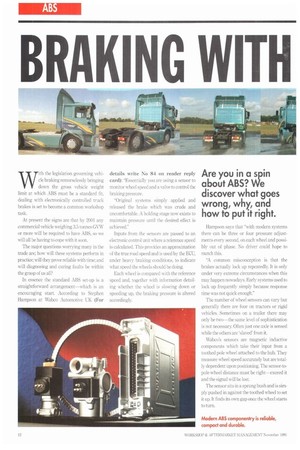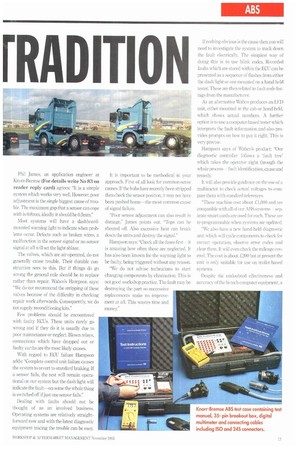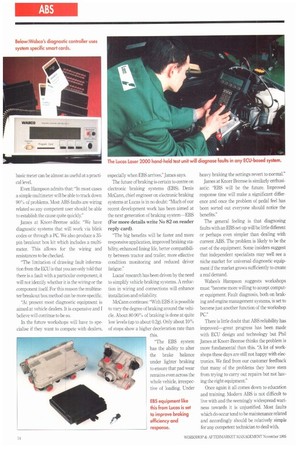BRAKING WITH
Page 62

Page 63

Page 64

If you've noticed an error in this article please click here to report it so we can fix it.
'RADII ON
Are you in a spin about ABS? We discover what goes wrong, why, and how to put it right.
ith the legislation governing vehi cle braking remorselessly bringing down the gross vehicle weight limit at which ABS must be a standard fit, dealing with electronically controlled truck brakes is set to become a common workshop task.
At present the signs are that by 2001. any commercial vehicle weighing 3.5 tonnes GVW or more will be required to have ABS, so we will all be having to cope with it som.
The major questions worrying many in the trade are; how will these systems perform in practice; will they prove reliable with time and will diagnosing and curing faults be within the grasp of us all?
In essence the standard ABS set-up is a straightforward arrangement—which is an encouraging start. According to Stephen Hampson at Wabco Automotive UK (For details write No 84 on reader reply card): "Essentially you are using a sensor to monitor wheel speed and a valve to control the braking pressure.
"Original systems simply applied and released the brake which was crude and uncomfortable. A holding stage now exists to maintain pressure until the desired effect is achieved.
Inputs from the sensors are passed to an electronic control unit where a reference speed is calculated. This provides an approximation of the true road speed and is used by the ECU, under heavy braking conditions, to indicate what speed the wheels should be doing.
Each wheel is compared with the reference speed and, together with information detailing whether the wheel is slowing down or speeding up, the braking pressure is altered accordingly. Hampson says that ''with modern systems there can be three or four pressure adjustments every second, on each wheel and possibly out of phase. No driver could hope to match this.
"A common misconception is that the brakes actually lock up repeatedly It is only under very extreme circumstances when this may happen nowadays. Early systems used to lock up frequently simply because response time was not quick enough."
The number of wheel sensors can vary but generally there are four on tractors or rigid vehicles. Sometimes on a trailer there may only be two—the same level of sophistication is not necessary. Often just one axle is sensed while the others are 'slaved' from it.
Wabco's sensors are magnetic inductive components which take their input from a toothed pole wheel attached to the hub. They measure wheel speed accurately but are totally dependent upon positioning. The sensor-topole-wheel distance must be right—exceed it and the signal will be lost.
The sensor sits in a sprung bush and is simply pushed in against the toothed wheel to set it up. It finds its own gap once the wheel starts to turn. Phil James, an application engineer at Knorr-Bremse (For details write No 83 on reader reply card) agrees: "It is a simple system which works very well, however, poor adjustment is the single biggest cause of trouble. The maximum gap that a sensor can cope with is 0.8mm, ideally it should be 0.5mm."
Most systems will have a dashboardmounted warning light to indicate when problems occur. Defects such as broken wires, a malfunction in the sensor signal or no sensor signal at all will set the light ablaze.
The valves, which are air-operated, do not generally cause trouble. Their durable construction sees to this. But if things do go wrong the general rule should be to replace rather than repair. Wabco's Hampson says: "We do not recommend the stripping of these valves because of the difficulty in checking repair work afterwards. Consequently, we do not supply reconditioning kits."
Few problems should be encountered with faulty ECUs. These units rarely go wrong and if they do it is usually due to poor maintenance or neglect. Blown relays, connections which have dropped out or faulty earths are the most likely causes.
With regard to ECU failure Hampson adds: "Complete control unit failure causes the system to revert to standard braking. If a sensor fails, the rest will remain operational on our system but the dash light will indicate the fault—on some the whole thing is switched off if just one sensor fails."
Dealing with faults should not be thought of as an involved business. Operating systems are relatively straightforward now and with the latest diagnostic equipment tracing the trouble can be easy. It is important to be methodical in your approach. First of all look for common-sense causes. If the hubs have recently been stripped then check the sens4)r position, it may not have been pushed home—the most common cause of signal failure.
"Poor sensor adjustment can also result in damage,James points out. "Thps can be sheered off. Also excessive heat can break down the units and destroy the signal."
I Lawson says: "Check all the fuses firstit is amazing how often these are neglected. It has also been known for the warning light to be faulty, being triggered without any reason.
"We do not advise technicians to start changing components by elimination. This is not good workshop practice. The fault may be destroying the part so successive replacements make no improvement at all. This wastes time and money." If nothing obvious is the cause then you will need to investigate the system to track down the fault electrically. The simplest way of doing this is to use blink codes. Recorded faults which are stored within the ECU can be presented as a sequence of flashes from either the dash light or one mounted on a hand-held tester. These are then related to fault code listings from the manufacturer.
As an alternative Wahro produces an LED unit, either mounted in the cab or hand-held, which shows actual numbers. A further option is to use a computer-based tester which interprets the fault information and also provides prompts on how to put it right. This is very precise.
Hampson says of WabcoS product: Our diagnostic controller follows a 'fault tree' which takes the operator right through the whole process fault identification, cause and remedy.
It. will also provide guidance on the use of a multimeter to check actual voltages to compare them with standard references.
"These machine cost abot LI.000 and are compatible with all of our ABS systemsseparate smart cards are used for each. These are re-programmable when systems are updated.
"We also have a new hand-held diagnostic unit which will cycle components to check for correct operation, observe en-or codes and clear them. It will even check the mileage covered. The cost is about ,C200 but at present the unit is only suitable for use on trailer-based systems, Despite the undoubted effectiveness and accuracy of the hi-tech computer equipment, a basic meter can be almost as useful at a practical level.
Even Hampson admits that: "In most cases a simple multimeter will be able to track down 90% of problems. Most ABS faults are wiring related so any competent user should be able to establish the cause quite quickly."
James at Knorr-Bremse adds: "We have diagnostic systems that will work via blink codes or through a PC. We also produce a 35pin breakout box kit which includes a multimeter. This allows for the wiring and resistances to be checked.
"The limitation of drawing fault information from the ECU is that you are only told that there is a fault with a particular component, it will not identify whether it is the wiring or the component itself. For this reason the multimeterThreakout box method can be more specific.
"At present most diagnostic equipment is aimed at vehicle dealers. It is expensive and I believe will continue to be so.
In the future workshops will have to specialise if they want to compete with dealers, especially when EBS arrives," James says.
The future of braking is certain to centre on electronic braking systems (EBS). Denis McCann, chief engineer on electronic braking systems at Lucas is in no doubt: "Much of our recent development work has been aimed at the next generation of braking system—EBS (For more details write No 82 on reader reply card).
"The big benefits will be faster and more responsive application, improved braking stability, enhanced lining life, better compatibility between tractor and trailer, more effective condition monitoring and reduced driver fatigue."
Lucas' research has been driven by the need to simplify vehicle braking systems. A reduction in wiring and connections will enhance installation and reliability.
McCann continues: "With EBS it is possible to vary the degree of braking around the vehicle. About 80-9000 of braking is done at quite low levels (up to about 0.20. Only about 10°0 of stops show a higher deceleration rate than this. heavy braking the settings revert to normal."
James at Knorr Bremse is similarly enthusiastic: "EBS will be the future. Improved response time will make a significant difference and once the problem of pedal feel has been sorted out everyone should notice the benefits."
The general feeling is that diagnosing faults with an EBS set-up will be little different or perhaps even simpler than dealing with current ABS. The problem is likely to be the cost of the equipment. Some insiders suggest that independent specialists may well see a niche market for universal diagnostic equipment if the market grows sufficiently to create a real demand.
Wabco's Hampson suggests workshops must "become more willing to accept computer equipment. Fault diagnosis, both on braking and engine management systems, is set to become just another function of the workshop PC."
There is little doubt that ABS reliability has improved—great progress has been made with ECU design and technology but Phil James at Knorr-Bremse thinks the problem is more fundamental than this. "A lot of workshops these days are still not happy with electronics. We find from our customer feedback that many of the problems they have stem from trying to carry out repairs but not having the right equipment."
Once again it all comes down to education and training Modern ABS is not difficult to live with and the seemingly widespread wariness towards it is unjustified. Most faults which do occur tend to be maintenance related and accordingly should be relatively simple for any competent technician to deal with.




























































































































